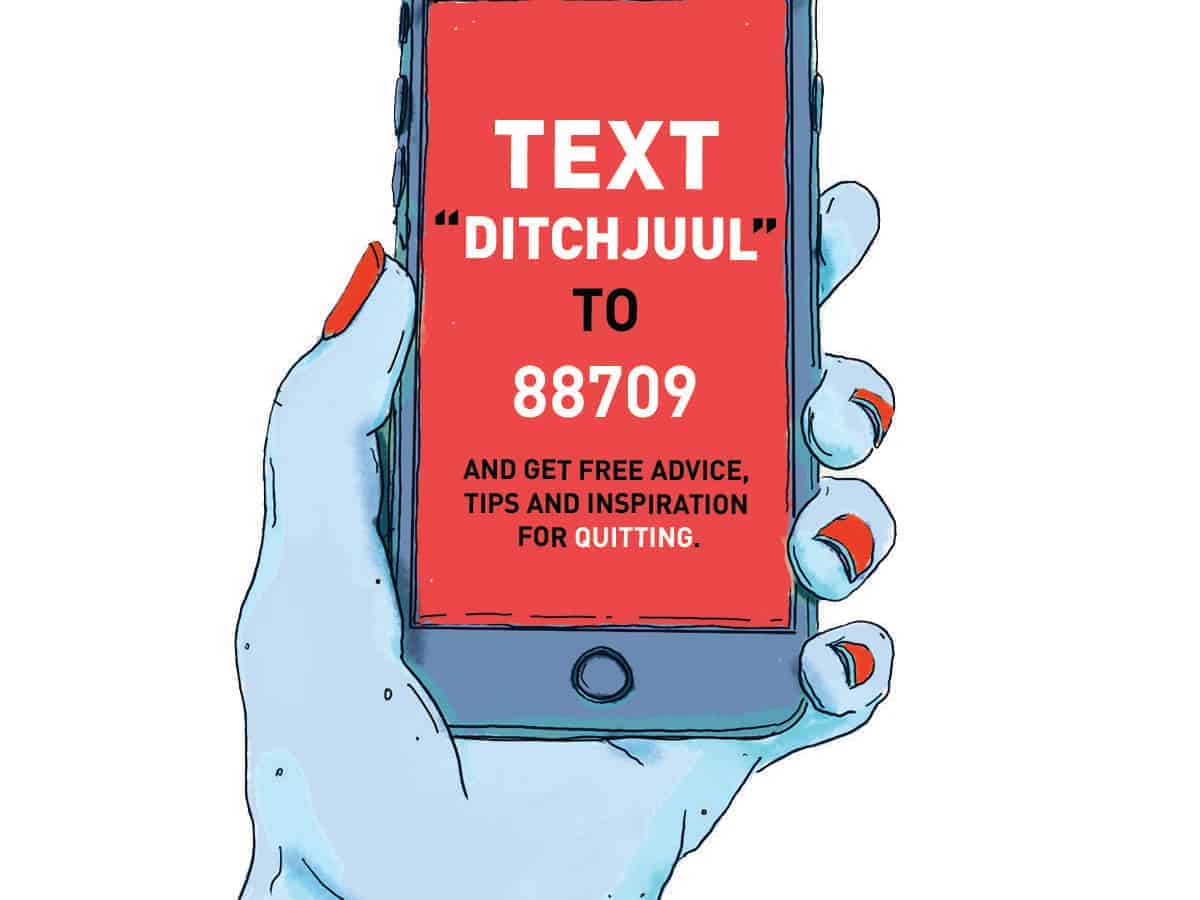
In January, the Truth Initiative, a nonprofit organization dedicated to tobacco use prevention and cessation, launched This is Quitting. Within the first five weeks, more than 27,000 teens (ages 13-17) and young adults (ages 18-24) enrolled in the text message-based e-cigarette quit program. To date, the program has subscribed more than 41,000 young people and averages between 100-150 new subscribers each day.
The entirely automated program adapts what is known from research in quitting regular cigarettes with qualitative research gained from young people who vape to provide actionable tips and strategies around breaking the habit of vaping and understanding the power of nicotine addiction. According to the campaign, it all starts with texting in “DITCHJUUL” to the short code 88709.
The code specifically recognizes one of the most popular vaping products among young people created by Juul Labs, Inc., which holds over 70% of the e-cigarette market share. Also unique to Juul: they entered the market with twice the levels of nicotine as competing products at 5% nicotine (the same amount of nicotine as one pack of cigarettes).
Juul came under fire by the Food and Drug Administration last year and faced a hearing by Congress earlier this year due to allegations that they have marketed their products to youth, creating an epidemic of youth addicted to vaping. In May, Attorney General Josh Stein filed a lawsuit against Juul Labs, Inc., making North Carolina the first state in the country to do so.
“The primary reason that we stepped into this space and created this program was seeing posts all over social media from young people asking for help: ‘How do I quit vaping? How do I do this?'” said Dr. Amanda Graham, who leads the Innovation Center behind the digital quitting products at Truth Initiative.
Graham recalled seeing a video of a young woman who took a hatchet to her Juul because that was the only strategy that she could think of to break the addiction. While it may have seemed like an extreme option, quitting therapies for young people addicted to nicotine aren’t exactly easy to find — or even effective. Nicotine-replacement therapies (like gums and patches) aren’t approved for use in people under the age of 18 and school-based and community-based tobacco intervention programs have struggled, Graham said.
“Certainly having to disclose to an adult, to a parent, to a healthcare provider, is a major barrier to getting treatment,” she said. “Most kids don’t want to talk about the fact that they’re addicted. And so being able to engage with a program anonymously and discreetly, our hope is that we can get this information out in as many places as young people will see it and they can text into a short code and immediately start receiving treatment.”
Outreach efforts to date have been based on earned media with successful enrollment spikes due to stories that have run on Mashable’s Snapchat channel. The Truth Initiative will be launching a paid media campaign for the quitting program at the end of September.
Even though the organization is fairly early on in outreach for the program that was developed in late 2018, Graham said the quitting tool has achieved very high levels of engagement, and in an initial evaluation, three-quarters of subscribers requested that the program be even longer. Since then, the text-in program has been extended from 30 days to two months. These initial study results are published in Nicotine and Tobacco Research.
“Frankly, we’ve been thrilled,” Graham said of enrollment and engagement. “We had seen the potential need and plea for help on social media, but when we launched the program we really had no expectations in terms of the volume of enrollment. What we’ve seen since then, I think, is the tip of the iceberg.”
The success of the text-in program is in line with extensive evidence in studies that have demonstrated the power of text messaging interventions for adults and young adults.
“At the very beginning of the program, one of the things that we do is to pose an open-ended question much like a clinician would in engaging somebody in a face-to-face interaction to get them to talk about the reasons that they’re quitting, and we can do that quite easily through text messaging,” Graham said.
The program has also received high engagement for on-demand support by texting in keywords like “CRAVE,” “STRESS,” or “SLIP.”
Additional tobacco cessation strategies have been drawn from a long-standing partnership with the Mayo Clinic Nicotine Dependence Center, which Graham described as the “preeminent leader in treating tobacco addiction.” However, unlike other quitting projects, this program has been entirely developed and funded in-house by the Truth Initiative.
In developing the program, researchers were aware of another key interest area when it comes to young people quitting vaping: parents. Under a separate initiative geared toward adult tobacco users called BecomeAnEx, the Truth Initiative team has also developed a program to support parents of kids who are vaping as they navigate their way through supporting their child. Parents and other adults looking to help young people quit should text “QUIT” to 202-899-7550.
For more of our coverage on youth vaping, click here.


